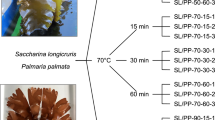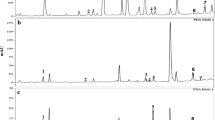Abstract
The main taste compounds of the water-soluble extract (WSE) of dry-cured ham are free amino acids (FAAs) and small peptides. At present there are many extraction methods for the WSE with pure water, HCl–ethanol, ethanol, alkaline and boiled water as solvent. These methods were studied on the basis of the extraction of FAAs, recovery of peptides and the volatile compounds as the index. Results showed the WSE of Jinhua ham extracted using pure water, had the highest percentage (19.57%) of the peptides with molecular weight of 200–300 Da. Most importantly it had the most similar taste characteristics to the raw ham during the sensory evaluation; with salt and sweet taste. In addition, the recovery of peptides was high (36.11%), though the alkaline method was much more effective for extraction (37.05%), the astringent taste dominated during the sensory evaluation. Otherwise, from the viewpoint of FAAs, we could see they mainly provide the umami taste. Considering the interactions between taste compounds and the aroma compounds, the latter obtained using the five methods were identified and significant differences were noted.


Similar content being viewed by others
References
Aristoy FC, Toldrá F (1995) Isolation of flavor peptides from raw pork meat and dry-cured ham. Develop Food Sci 32B:323–1344
Delahunty CM, Piggott JR (1995) Current methods to evaluate contribution and interactions of components to flavor of solid foods using hard cheese as an example-review. Int J Food Sci Tech 30:555–570
Solms J (1986) Interactions of non-volatile and volatile substances in foods. In: Birch GG, Lindley MG (eds) Interactions of food components, Elsevier Applied Science, London, pp 189–210
Pionnier E, Engel E, Salles C, Le Quere JL (2002) Interactions between non-volatile water-soluble molecules and aroma compounds in Camembert cheese. Food Chem 76:13–20
Virgili R, Parolari G, Schivazappa C, Casiraghi E, Pompei SC (1994) Sensory analysis of Italian dry-cured sausage: checking of panel performance. Lebensmittel-Wissenschaft und-Tech 27:278–281
Sentandreu MA, Stoeva S, Aristoy MC, Laib K, Voelter W, Toldra E (2003) Identification of small peptides generated in Spanish dry-cured ham. J Food Sci 68:64–69
Flores M, Aristoy MC, Spanier AM, Toldra F (1997) Non-volatile components effects on quality of “Serrano” dry-cured ham as related to processing time. J Food Sci 62:1235–1239
Ruiz J, García C, Carmen Díaz M, Cava R, Florencio Tejeda J, Ventanas J (1999) Dry cured Iberian ham non-volatile components as affected by the length of the curing process. Food Res Int 32:643–651
Hansen LL, Larsen AE, Hammershøj M, Sørensen P, Hansen-Møller J J (1999) Influence of aromatic components from pig manure on odour and flavor of cooked chicken meat. Meat Sci 52:325–330
Virgili R, Parolari G, Schivazappa C, Casiraghi E, Pompei C (1994) Sensory analysis of Italian dry-cured sausage: checking of panel performance. Lebensmittel-Wissenschaft und-Tech 27:278–281
Gill I, López-Fandińo R, Jorba X, Vulfson EN (1996) Biologically active peptides and enzymatic approaches to their production. Enzyme Micro Tech 18:162–183
Wang K, Maga JA, Bechtel PJ (1996) Flavor characteristics of glutathione in raw and cooked foodstuffs. Taste properties and synergisms of beefy meaty peptide. J Food Sci 61:837–839
Martín L, Antequera T, Ventanas J, Benítez-Donoso R, Cordob JJ (2001) Free amino acids and other non-volatile compounds formed during processing of Iberian ham. Meat Sci 59:363–368
Zhao GM, Zhou GH, Tian W, Xu XL, Wang YL, Luo X (2005) Changes of alanyl aminopeptidase activity and free amino acid contents in biceps femoris during processing of Jinhua ham. Meat Sci 71:612–619
Barat JM, Grau R, Ibáñez JB, Pagán MJ, Flores M, Toldrá F, Fito P (2006) Accelerated processing of dry-cured ham part I. Viability of the use of brine thawing/salting operation. Meat Sci 72:757–765
AOAC (1990) Official methods of analysis, 15th edn. Association of Official Analytical Chemists, Arlington
Bañón S, Cayuela JM, Granados MV, Garrido MD (1999) Pre-cure freezing affects proteolysis in dry-cured hams. Meat Sci 51:11–16
Parka YW, Drake MA (2005) Effect of 3 months frozen-storage on organic acid contents and sensory properties, and their correlations in soft goat milk cheese. Small Ruminant Res 58:291–298
Engel E, Lombardot JB, Garem A, Leconte N, Septier C, Le Quéré JL, Salles C (2002) Fractionation of the water-soluble extract of a cheese made from goats’ milk by filtration methods: behavior of fat and volatile compounds. Int Dairy J 12:609–619
Drake MA, Yates MD, Gerard PD, Delahunty CM, Sheehan EM, Turnbull RP, Dodds TM (2005) Comparison of differences between lexicons for descriptive analysis of Cheddar cheese flavor in Ireland, New Zealand, and the United States of America. Int Dairy J 15:473–483
Townsend WE, Olson DG (1987) The science of meat and meat products, price 3rd edn. Schweigert JF, BS (eds) Westport, CT, pp 431–456
Ding NK (1996) Flavor Chem Food. Light Industry Publishing Company, Beijing
Bolzoni L, Careri M, Mangia A (1990) Characterization of volatile components in apricot purées by gas chromatography-mass spectrometry. J Chromatogr A 518:221–229
Mateo J, Domínguez MC, Aguirrezábal MM, Zumalacárregui JM (1996) Taste compounds in chorizo and their changes during ripening. Meat Sci 44:2455–2540
Molina E, Mercedes R, Alonso L, López-Fandiño R (1999) Contribution of low molecular weight water soluble compounds to the taste of cheeses made of cows’, ewes’ and goats’ milk. Int Dairy J 9:613–621
Zhang JH, Zhou GH, Zhu JH, Ma AF (2004) Changes of free-amino acid and volatile flavor compounds and its correlations in traditional processing of Jinhua ham. J Nanjing Agri Univers 27:96–100
Shahidi F (1998) Flavor of meat, meat products and seafoods (eds 2), Inc., Maryland, USA
Careri M, Mangia A, Barbieri G, Bouoni L, Virgili R, Parolari G (1993) Sensory property relationships to chemical data of Italian-type dry-cured ham. J Food Sci 58:968–972
Mottram DS (1998) Flavor formation in meat and meat products: a review. Food Chem 62:415–424
Erwan E, Lombardota JB, Garemb A, Leconteb N, Septiera C, Quere Jean-Luc L, Salles C (2002) Fractionation of the water-soluble extract of a cheese made from goats’ milk by filtration methods: behavior of fat and volatile compounds. Int Dairy J 12:609–619
Thanh ML, Thibeaudeau P, Thibaut MA, Voilley A (1992) Interactions between volatile and non-volatile compounds in the presence of water. Food Chem 43:129–135
Druaux C, Voilley A (1997) Effect of food composition and microstructure on volatile flavor release. Trends Food Sci Tech 8:364–368
Puyol P, Dolores P, Mata L, Ena JM, Calvo M (1993) Effect of retinol and fatty acid binding by bovine β-lactoglobulin on its resistance to trypsin digestion. Int Dairy J 3:589–597
Murphy C, Cain WS, Bartoshuk LM (1977) Mutual action of taste and olfaction. Sense Process 5:204–211
Salles C, Hervé C, Septier C, Demaizières D, Lesschaeve I, Issanchou S, Le Quéré JL (2000) Evaluation of taste compounds in water-soluble extract of goat cheeses. Food Chem 68:429–435
Author information
Authors and Affiliations
Corresponding author
Rights and permissions
About this article
Cite this article
Dang, Y.L., Wang, Z. & Xu, S.Y. Methods for extracting the taste compounds from water soluble extract of Jinhua ham. Eur Food Res Technol 228, 93–102 (2008). https://doi.org/10.1007/s00217-008-0910-2
Received:
Revised:
Accepted:
Published:
Issue Date:
DOI: https://doi.org/10.1007/s00217-008-0910-2




